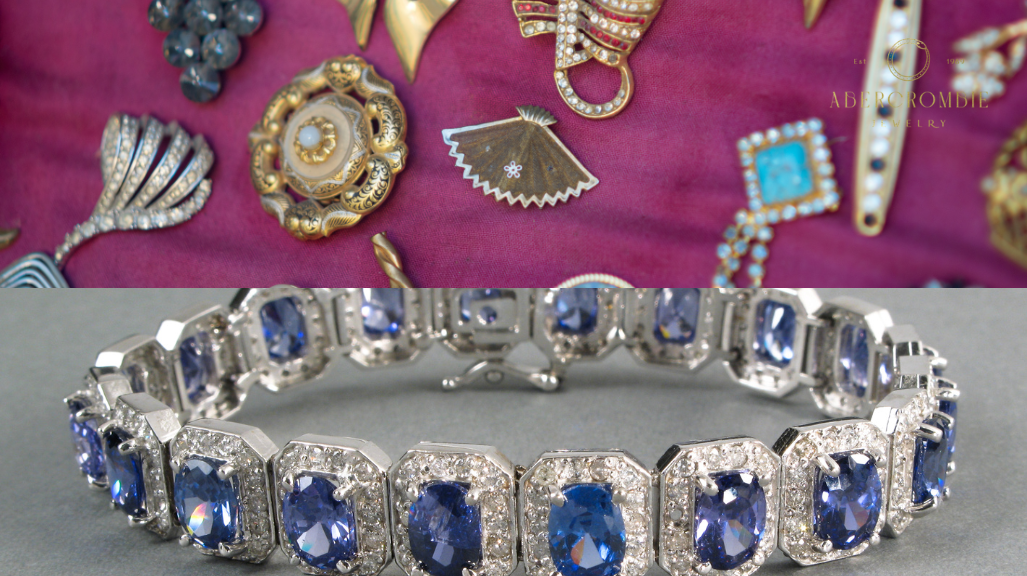Whether it’s a diamond ring that has been handed down for generations, a pair of exquisite gold earrings, or another piece of jewelry that embodies art, there is often confusion between the terms “antique” and “estate.” This is especially true when you consider that one piece of jewelry can fall under both categories.
Abercrombie Jewelry helps you differentiate between the two and also provides some more useful information that could very well be useful for your collection.
What Is the Difference Between Antique and Estate Jewelry?

Antique Jewelry
If a piece of fine jewelry is considered antique, the description is based on mostly when it was crafted. In general, jewelry is considered antique once it is over 100 years old. Additionally, the craftsmanship style tells the tale. You may find that antique jewelry comes in a series of custom designs that are generally made from more high-quality materials than modern options on today’s market.
Estate Jewelry
The term “estate” here speaks more to lineage than time. Once the piece had at least one previous owner, it falls under this umbrella. Imagine that you grew up in Austin, TX, for example, and there was a beautiful piece of jewelry owned by someone a long time ago from the city that now belongs to you. It would be seen as estate jewelry.
This is also a good time to dispel the myth that previous owners of estate jewelry are typically deceased. They could be very much alive and that changes nothing about the classification.
Additionally, age has nothing to do with the description. Sure, a piece of estate jewelry may be 100 years old or more (making it an antique too), but it could also be much younger.
Read: 7 Mistakes to Avoid During Estate Jewelry Appraisal
What About Vintage Jewelry?
Vintage pieces also find themselves in this conversation, with people wondering if they are much different from the two categories highlighted above. Like antiques, the vintage umbrella considers age, with pieces falling under it if they are between 50 and 100 years old.
Necklaces, bracelets, rings, and other pieces considered vintage are often worn unlike their antique counterparts since the latter are more susceptible to breakage.
Additionally, the younger age of vintage pieces means that their style is more akin to current-day pieces.
Is Estate Jewelry Worth Buying?

Historical Significance
When you see an individual or business decide to sell estate jewelry, they are selling a piece of history. Sure, the diamonds on that one ring are beautiful, but what is its history? Was it an engagement ring used for a royal proposal, perhaps?
For those who like these kinds of jewelry, a part of the true value lies in the tales and their associated level of mystery. After all, who doesn’t like to feel as if they are a part of something bigger than themselves?
Sustainability
Estate jewelry purchases tend to contribute to the conservation of resources rather than their consumption. Even if you’re not the most environmentally conscious person, you can appreciate that you are living in a time when resource conservation on Earth is more important than ever.
Uniqueness
Unlike current-day jewelry, you wouldn’t find pieces of the past being mass-produced. This applies to vintage and antique jewelry too. If you have estate items from an era long gone, you would be hard-pressed to find an identical one anywhere.
Apart from not having a lot of duplicates, there was also the matter of accessibility back then. Much of the estate jewelry you can shop for now was simply not for purchase by the masses in the past. These factors make the items even rarer and more valuable.
Authenticity
It’s very easy for you to go to a store to buy silver, gold, and other kinds of jewelry inspired by the past with authentic gemstones too. However, regardless of how beautiful these pieces are, they simply cannot hide their age, if even because of a small detail. Buying estate jewelry of a bygone era means getting authentic items that relied on the crafting methods and materials from that time.
Does Antique Jewelry Hold Its Value?
Much of the value discussion surrounding jewelry depends on rarity and craftsmanship. Consider that diamonds were super rare and expensive in the 1800s. However, since diamond mines were discovered in South Africa, that changed.
Be that as it may, the value principle holds true. Antique pieces are known for excellent craftsmanship and being incredibly rare, thanks to the past norms of jewelry creation and distribution highlighted above. Therefore, you will find that they hold their value and may even appreciate.
What Jewelry Does Not Lose Value?

Palladium
Though palladium was discovered in 1803, it remains one of the rarest materials, even beating platinum and gold in that regard. It tends to rise in value over time, making it a great investment if you can get your hands on it.
Platinum
Like gold, platinum is also very good at maintaining its worth and this applies to both jewelry and industrial applications. Bear in mind that platinum is about 15 times rarer than gold and being dense yet moldable does not hurt it either.
The Bottom Line
While estate jewelry speaks to items that had previous owners, antique jewelry is any piece that is over 100 years old, meaning that one item could fall under both categories. Buying either type can be very beneficial because of the value, uniqueness, sustainability, etc.

